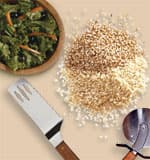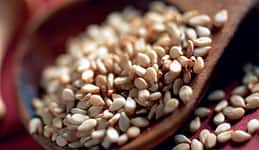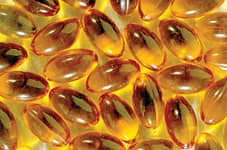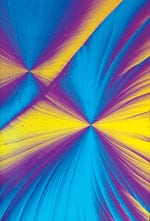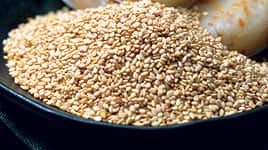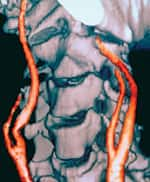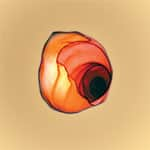Life Extension Magazine®
Scientists have unanimously concluded that free radicals damage cells and contribute to the common diseases associated with aging. Health-conscious people today consume antioxidant supplements to help neutralize these toxic free radicals. As people age, however, they generate more free radicals that inflict greater damage to cellular DNA, mitochondria, and cell membranes. The result is illness and premature death, even in those who take conventional antioxidant supplements. Back in 1980, the Life Extension Foundation first recommended antioxidants to reduce the risk of disease. While our pioneering work has been validated in tens of thousands of published studies, extraordinary efforts are required to counteract the increased levels of free radicals to which aging people are exposed. The encouraging news is that researchers have discovered more potent antioxidants that significantly boost our defenses against destructive free radical attack. For instance, new forms of lipoic acid called R-lipoic acid and R-dihydro-lipoic acid provide much greater protection against free radical reactions inside the cell. (These new forms of lipoic acid are discussed in the article that follows the one you are about to read.) What has us most excited is that sesame lignans can amplify the antioxidant efficacy of vitamin E, including critically important gamma tocopherol. Vitamin E is an essential, fat-soluble antioxidant that inhibits fatty acid oxidative damage in cell and mitochondrial membranes. The problem until now has been that the amount of gamma tocopherol and other vitamin E compounds that could be delivered to the tissues was limited. Adding standardized sesame lignans to dietary supplements, however, enhances the ability of these compounds to quench free radicals and thus provide greater protection against destructive free radical attack. This article discusses some remarkable findings about sesame lignans and why they have become so important to those seeking to derive optimal benefits from their dietary supplement program. Sesame (Sesamum indicum), one of the world’s oldest cultivated foods, has been valued throughout history for its contributions to diet, medicine, and household uses. Modern research reveals that this long-prized plant offers a wealth of health benefits. Sesame and its lignans boost antioxidant levels, reduce inflammation, normalize blood pressure, improve lipid levels, and promote fat burning. They act synergistically with other nutrients such as gamma tocopherol, fish oil, and conjugated linoleic acid, thereby enhancing the bioavailability and effectiveness of those nutrients. Through its many biochemical actions, sesame may help in managing some of today’s most pressing health concerns, including heart disease, high blood pressure, obesity, and inflammatory disorders. Sesame arrived in the Middle East from Africa some 5,000 years ago. It was especially well suited to the region due to its high resistance to oxidation and rancidity in warm climates. Sesame was incorporated in traditional folk remedies throughout Asia and the Middle East, where it was used to treat conditions ranging from colds and flu to asthma and jaundice. Today, sesame seeds play an important role in Ayurveda, the ancient healing tradition of India, and sesame products are consumed in Japan and China as health foods to prevent aging.1,2 Modern research has found that sesame seeds offer a broad range of health benefits. Sesame may be especially well suited to helping reduce the risk of heart disease, the leading killer of men and women in America today. Numerous biochemical processes can contribute to the pathogenesis of heart disease, including unfavorable lipid profiles, oxidative stress, elevated blood pressure, and reduced levels of protective antioxidants. Sesame and its lignans—fibrous compounds that may act as antioxidants and influence hormone metabolism—may be valuable therapeutic tools in modulating cardiovascular risk through their numerous actions in the body. Sesame lignans have been found to enhance the anti-inflammatory effects of essential fatty acids, lower total cholesterol and low-density lipoprotein (LDL), block oxidative damage implicated in atherosclerosis, and reduce blood pressure. Sesame lignans can dramatically increase tissue and serum levels of the vitamin E fractions alpha tocopherol and gamma tocopherol, thereby enhancing their protective properties.3 Studies have shown that sesame can also reduce inflammatory processes known to promote cancer, senescence, and aging.
Unique Benefits of Gamma TocopherolEarly research on vitamin E focused on alpha tocopherol, the form most commonly found in supplements. When scientists started examining other vitamin E fractions, one in particular—gamma tocopherol—was found to possess several unique properties. Although not as powerful an antioxidant as alpha tocopherol, gamma tocopherol was found to be the only vitamin E fraction capable of quenching reactive nitrogen oxide species such as peroxynitrite and nitrogen dioxide. Generated by inflammation, these dangerous free radicals are implicated in a host of degenerative diseases, including atherosclerosis, AIDS dementia complex, amyotrophic lateral sclerosis, Alzheimer’s disease, Huntington’s disease, multiple sclerosis, and Parkinson’s disease.4,5 Re-searchers also discovered that gamma tocopherol and its water-soluble metabolite, gamma-CEHC, reduce inflammation by inhibiting prostaglandin E2 (PGE-2).6 In addition to inhibiting chronic inflammation, gamma tocopherol exerts additional non-antioxidant effects to prevent cancer.7 Gamma tocopherol is believed to prevent colon cancer by inhibiting the formation of mutagens produced by oxidized fecal fats, while decreasing oxidative damage to the epithelial cells of the colon.8 Gamma tocopherol may act as a chemopreventive agent to prevent prostate and colorectal cancers by influencing biological mechanisms involved in cell death, cell cycle, and gene transcription.9 High serum levels of gamma tocopherol have been correlated with a lowered incidence and reduced risk of death from cardiovascular disease. In one study involving 34,486 postmenopausal women, increased intake of dietary vitamin E, primarily gamma tocopherol, was associated with a reduced risk of death from coronary heart disease.10 This association was not observed in women who took vitamin E supplements of alpha tocopherol. Sesame Lignans Boost Gamma TocopherolAs the health benefits of gamma tocopherol became more apparent, researchers were puzzled to find that although gamma tocopherol is the primary form of vitamin E in the diet, blood serum levels of alpha tocopherol are four to ten times higher than those of gamma tocopherol.11 Researchers were further intrigued to discover that supplementing the diet with alpha tocopherol results in significantly lower gamma tocopherol levels, both in the blood and in tissues.12,13 Several factors contribute to the problem of raising gamma tocopherol levels in humans. First, although gamma tocopherol and alpha tocopherol are absorbed equally in the intestines, the carrier protein that transports vitamin E from the liver to the tissues is highly selective for alpha tocopherol, transporting the alpha fraction in a 20:1 ratio compared to the other tocopherols. As a result, relatively little gamma tocopherol ends up in cell membranes.14 Additionally, the liver’s P-450 enzyme responsible for breaking down vitamin E tocopherol—omega-hydroxylase—exhibits a markedly higher catalytic activity for gamma tocopherol than for alpha tocopherol, which is why taking alpha tocopherol by itself ends up suppressing serum and tissue levels of gamma tocopherol.15 Increasing one’s intake of alpha tocopherol actually depresses gamma tocopherol levels, whereas adding gamma tocopherol to the diet increases serum and tissues levels of both gamma tocopherol and alpha tocopherol.16 This finding may explain why vitamin E from dietary sources has been found to be more effective than alpha tocopherol supplements in reducing deaths from cardiovascular disease.
Sesame’s Effects on Tocopherol MetabolismIn a series of experiments, researchers discovered that serum levels of alpha tocopherol actually increased when rats deprived of alpha tocopherol were supplemented with sesame. In one of the experiments, rats were fed one of five different diets: a control diet free of vitamin E; a diet low in alpha tocopherol; or one of three diets low in alpha tocopherol but supplemented with 5%, 10%, or 15% sesame seed content, respectively. The researchers examined changes in lipid peroxides in the liver, red blood cell hemolysis, and pyruvate kinase activity, as indices of vitamin E deficiency. These indices were high in the diet that was low in alpha tocopherol, whereas supplementation with even 5% sesame seed suppressed these indices completely and caused a significant increase in alpha tocopherol in the plasma and liver. These experiments revealed that sesame seed lignans significantly enhance vitamin E activity and increase alpha tocopherol concentrations in the blood and tissue of rats fed a diet containing alpha tocopherol and sesame seed or its lignans.17 In a related study, researchers examined liver, brain, kidney, and serum levels of gamma tocopherol in rats fed either gamma tocopherol alone or gamma tocopherol in combination with sesame. Rats receiving only gamma tocopherol exhibited small increases of gamma tocopherol in their tissues and serum. By contrast, rats fed a mixture of sesame and gamma tocopherol had significant increases— ranging from 833% to 1,000%—in gamma tocopherol levels in both their serum and tissues. The researchers also noted that urinary excretion of gamma-CEHC, the water-soluble metabolite of gamma tocopherol, declined by 50% in the sesame-supplemented rats.14 Japanese researchers recently examined the effects of sesame and sesame lignans on tocopherol metabolism to clarify the mechanism responsible for raising gamma tocopherol levels. They found that urinary levels of gamma-CEHC in rats fed sesamin or the sesame lignan sesaminol were markedly lower than in rats fed gamma tocopherol alone. The researchers concluded that sesame seed and sesame lignans elevate gamma tocopherol concentration by inhibiting an enzyme involved in breaking down tocopherols and tocotrienols.14 | |||
Sesame Elevates Gamma Tocopherol, Inhibits LDLIn 2001, researchers from the University of Hawaii Cancer Research Center tested nine subjects by feeding them muffins containing equivalent amounts of gamma tocopherol derived from sesame seeds, walnuts, or soy oil. Eating muffins containing sesame increased serum levels of gamma tocopherol by 20% in as little as three days. No similar benefit was seen in subjects eating muffins containing gamma tocopherol derived from walnuts or soy oil. All of the subjects who consumed muffins containing sesame seeds had detectable levels of the sesame lignan sesamolin in their plasma. According to the study authors, “consumption of moderate amounts of sesame seeds appears to significantly increase plasma gamma tocopherol and alter plasma tocopherol ratios in humans and is consistent with the effects of dietary sesame seeds observed in rats leading to elevated plasma gamma tocopherol and enhanced vitamin E bioactivity.”18 In another study also conducted in 2001, Swedish women who consumed dietary sesame oil saw their gamma tocopherol levels increase 41% from their pre-supplementation levels—without affecting serum alpha tocopherol concentration.19 This effect could be due to the gamma tocopherol or the lignans present in sesame oil, or the interaction of both. Oxidation of dangerous low-density lipoprotein (LDL) is a primary initiating event in the development of atherosclerosis.20 LDL oxidation occurs when oxidants such as peroxynitrite radical, iron ascorbate, and copper ascorbate modify LDL particles. Once LDL is oxidized, it can no longer be recognized by LDL receptors, but instead is targeted by scavenger receptors on macro-phages, leading to the formation of lipid-filled foam cells observed in atherosclerotic lesions.21 Researchers have found that sesame lignans are highly effective inhibitors of LDL oxidation. In one test designed to measure the ability of various antioxidants to inhibit oxidation, LDL was exposed to a standardized oxidizing agent, such as copper iron ascorbate (CuSO4), and then treated with various antioxidants to determine their potency. Butylated hydroxytoluene, or BHT, is a food preservative that has long been recognized as being among the most potent inhibitors of CuSO4-induced lipid peroxidation. In 1995, researchers at the University of Shizuoka, Japan, found that sesaminol, the most prevalent sesame lignan, effectively inhibited LDL oxidation, outperforming other well-established biological antioxidants, including quercetin, epigallocatechin-3 gallate (EGCG), theaflavin, BHT, and alpha tocopherol. In fact, the lag time to oxidation—the determining factor in antioxidant potency—was greatly increased.22 The lignan sesaminol is thus a strong antioxidant with powerful antioxidant effects.
Sesame Lignans Improve Lipid ProfilesSesame lignans have been shown to improve lipid profiles in both humans and experimental animals. Unfavorable lipid profiles are a significant risk factor for cardiovascular disease. In one study, re-searchers examined the effects of sesamin on cholesterol metabolism in rats. Their study found that animals fed sesamin (0.5% of their daily diet) for four weeks had significant reductions in serum and liver cholesterol levels, irrespective of the presence or absence of cholesterol in their diet.23 The researchers also noted a significant reduction in liver activity of 3-hydroxy-3-methylglutaryl coenzyme A reductase (HMG-CoA), the rate-limiting enzyme required for cholesterol biosynthesis. According to the study authors, “since sesamin lowered both serum and liver cholesterol levels by inhibiting absorption and synthesis of cholesterol simultaneously, it deserves further study as a possible hypocholesterolemic agent of natural origin.”23 A study in rabbits showed that sesame helped improve lipid profiles by lowering total cholesterol and triglyceride levels while increasing levels of protective high-density lipoprotein (HDL).24 In addition, sesame decreased susceptibility to oxidative stress in the rabbit study.24 When vitamin E and sesamin were added to the diets of rats, LDL and very low-density lipoprotein (VLDL) levels decreased while beneficial HDL increased significantly, favorably improving the atherogenic index.25 To determine whether sesame lignans affect cholesterol levels in human subjects, Japanese re-searchers recruited 12 male patients diagnosed with hyper-cholesterolemia (high cholesterol). One group of six patients was treated with 32 mg of sesamin per day, while the second (control) group received a placebo. After eight weeks of treatment, the sesamin-treated group was found to have lower total cholesterol, LDL, and apolipoprotein B levels. In the sesamin group, average total cholesterol levels dropped from 270 to 248 mg/dL, LDL levels fell from 187 to 156 mg/dL, and apolipoprotein B levels were reduced from 188 to 168 mg/dL, thus reducing several serious risk factors for cardiovascular disease. By contrast, in the placebo group, levels of total cholesterol, LDL, and apolipoprotein B were unchanged.26 Sesame Lignans Show Antihypertensive EffectsHypertension is a silent disease that that increases the risk of stroke, heart attack, and other serious disorders. Sesame lignans have demonstrated antihypertensive effects in animals and humans. In both normotensive and hypertensive stroke-prone rats, sesame exerts a mild antihypertensive effect.27 In high-salt diets, sesame prevented the development of hypertension and of histological renal damage such as thickening of the tunica intima and fibrinoid degeneration of the arterial wall.28-33 These findings may have implications for humans because of the high salt content in the American diet. A recent human study investigated the effects of sesame oil in hypertensive patients who were being treated with a calcium channel blocker (nifedipine). The study enrolled 396 hypertensive patients, including 215 men and 181 women, with an average age of 58. Forty patients were treated only with nifedipine, while 356 patients continued to use nifedipine while switching exclusively to sesame oil in place of other edible oils in their diet. After 60 days, the average systolic blood pressure in the sesame group was reduced from 166 mm Hg to 134 mm Hg, and the average diastolic pressure dropped from 101 mm Hg to 85 mm Hg.34
The nifedipine dosage was then reduced to adjust for the drop in blood pressure observed in patients consuming sesame oil. In the sesame group, plasma levels of sodium decreased, while potassium and chloride levels increased significantly. Levels of lipid peroxidation (thiobarbituric acid reactive substances) also decreased significantly, while activities of enzymic antioxidants (superoxide dismutase, glutathione peroxidase, and catalase) and concentrations of non-enzymic antioxidants (vitamins C and E, beta-carotene, and reduced glutathione) increased in sesame oil group.34 The results led study author Devarajan Sankar, DO, PhD, to observe, “the effect of the oil on blood pressure may be due to polyunsaturated fatty acids . . . and the compound sesamin . . . both compounds have been shown to reduce blood pressure in hypertensive rats. Sesame lignans also inhibit the synthesis and absorption of cholesterol in these rats.”34 Enhanced Actions of Essential Fatty AcidsEssential fatty acids are involved in many of the body’s biochemical processes. One of their most important roles is preventing inflammation. Dihomo-gamma-linolenic acid (DGLA) is an essential fatty acid produced from the conversion of gamma linolenic acid (GLA), which is found in borage, black currant, and evening primrose oil. DGLA can be directly converted into the anti-inflammatory prostaglandin E1 (PGE-1) at the expense of pro-inflammatory prostaglandin E2. PGE-1 has been shown to normalize blood pressure in hypertensive rats, and to help control inflammation and normalize blood pressure in humans. DGLA is needed to activate the immune system and prevents smooth muscle proliferation of arteries and veins, which leads to hardening of the arteries. DGLA is also needed in the diet to prevent blood-clot formation. DGLA levels are a key factor in human aging, and deficiencies of DGLA have been associated with accelerated aging. | ||||||
| In 1991, researchers in Kyoto, Japan, demonstrated that sesamin lignans effectively inhibit delta-5 desaturase, the enzyme responsible for converting DGLA into highly inflammatory arachidonic acid.35 This anti-inflammatory effect was also noted in animals that were fed linseed oil and sesame lignans. Linseed oil is a source of DGLA. Linseed and sesame lowered blood levels of tumor necrosis factor-alpha and PGE-2, two inflammatory mediators. Feeding rats sesame led to significant accumulations of DGLA in the tissues and reduced inflammation caused by tumor necrosis factor-alpha and PGE-2.36 An undesirable side effect of supplementing with highly polyunsaturated fats is increased production of free radicals. The addition of sesame lignans to fish oil can help lower lipid peroxidation rates caused by the fish oil. Sesame suppresses the formation of lipid peroxides from docosahexaenoic acid (DHA), which is highly susceptible to oxidation but is also one of the primary omega-3 fatty acids in fish oil that block inflammation. The combination of sesame with fish oil thus helps to enhance the fish oil’s anti-inflammatory effects by protecting it from lipid peroxidation.37
Sesame Lignans May Support Weight LossOptimizing the liver’s oxidation of fatty acids has been proposed to help promote fat loss.38 Numerous studies suggest that sesame lignans may aid in weight loss by enhancing fatty acid oxidation in liver tissues. In a study of rats, the addition of sesamin, one of the most abundant sesame lignans, increased the activity of numerous fatty acid oxidation enzymes.39 While this effect was observed in all groups of rats given various dietary oils, it was especially pronounced in rats consuming fish oil.39 Fish oil appears to act synergistically with sesame lignans to promote fat burning. Conjugated linoleic acid (CLA) is a fatty acid known to promote weight loss. In a study in rats, the addition of sesamin to CLA promoted even greater weight loss, as measured by a reduction in adipose tissue weight.40 Sesame lignans thus appear to have a synergistic effect, enhancing the benefits of fish oil and CLA in promoting optimal fat burning and healthy weight. New Study Confirms Sesame’s Synergistic EffectsIn response to these remarkable published studies on sesame, Life Extension conducted a clinical trial to see what would happen to people who took supplements containing gamma tocopherol and sesame lignans. To establish a baseline, three markers of oxidative stress and inflammation—dityrosine, isoprostane, and PLGF-1—were measured in the blood of a group of human test subjects. The group was then divided into two subgroups, with one subgroup given gamma tocopherol plus tocotrienols and the other receiving the same amount of gamma tocopherol plus sesame lignans. The dityrosine marker measures serum levels of deep-tissue protein oxidation caused by the peroxynitrite radical reacting with tyrosine, an amino acid found in all human proteins. Tyrosine is the amino acid most readily attacked by the pero-xynitrite radical, an extremely powerful free radical that has been implicated in a host of disorders. Gamma tocopherol is the only tocopherol that reacts with, or traps, the peroxynitrite radical to any appreciable degree. Compared to the gamma tocopherol-tocotrienol group, those taking gamma tocopherol plus sesame showed a 45% reduction in serum dityrosine oxidation levels after two weeks of supplementation.
The isoprostane marker measures the amount of cell membrane damage caused by free radicals. Also called lipid peroxidation, cell membrane damage involves a free radical chain reaction of cell membrane fatty acids. Normally, lipid peroxidation results in one free radical destroying 8 to 10 normal molecules before being quenched. Supplementing with vitamin E products can limit this destruction to one or two molecules rather than the normal 8-10 molecules that occurs without supplementation. Compared to the gamma tocopherol-tocotrienol group, those taking gamma tocopherol plus sesame showed a 22% reduction in serum isoprostane levels after two weeks of supplementation. The PLGF-1 marker is an extremely sensitive new test for atherosclerotic risk in humans. PLGF-1 stands for “placental growth factor” because it was originally identified in the placenta. For adults, however, high levels of PLGF-1 are indicative of atherosclerotic lesions. PLGF-1 stimulates vascular smooth muscle cell growth, recruits macrophages into atherosclerotic lesions, up-regulates production of tumor necrosis factor-alpha and stimulates undesirable angiogenesis. In the animal model, inhibition of PLGF-1 suppressed both atherosclerotic plaque growth and arterial wall inflammatory reactions. PLGF-1 may be considered a marker for the presence of unstable arterial wall plaque. Compared to the gamma tocopherol-tocotrienol group, those taking gamma tocopherol plus sesame showed an 11.5% reduction in serum PLGF-1 levels after two weeks of supplementation. Considering that the subjects in this experiment were a healthy group to begin with—with baseline PLGF-1 levels that were already in the lowest percentage quartile—the 11.5% reduction recorded in the gamma tocopherol plus sesame group was impressive. Presumably, those with arterial wall dysfunction, who normally have high PLGF-1 levels, would derive even greater benefit from supplements that lowered this very sensitive inflammatory marker. The same would hold true for aging adults whose baseline oxidative stress levels are very high compared to this healthy group of test subjects. Based on these three advanced measurements of free radical and inflammatory damage, gamma tocopherol plus sesame lignans is on average 25% more effective in reducing three biomarkers of oxidative stress and inflammation than the more expensive gamma tocopherol plus tocotrienols.
What is so impressive about this recent trial is that unlike previous studies, the effects of sesame were not compared to a placebo or control group. Instead, this human study compared the effects of supplementing with low-cost sesame to those of taking very expensive tocotrienols. The tocotrienols are considered nature’s most potent natural antioxidants. Yet in this study, sesame was found to work 25% better than the tocotrienols. SummarySesame and its lignans have been shown to possess multiple health benefits, both alone and in synergistic combination with other compounds, including gamma tocopherol and fish oil. Sesame lignans help to increase tissue and serum levels of biological antioxidants that have been strongly correlated with improved health in mammals and humans. Sesame lignans have also demonstrated anti-inflammatory benefits and block free radical lipid peroxidation in fish oil supplements to suppress inflammation. Lignans are powerful inhibitors of LDL oxidation, effectively reducing atherogenic processes. Lastly, lignans are potent stimulators of fatty acid oxidation, one of the key processes involved in weight control. By influencing biochemical processes in the body, sesame and its lignans promise to help reduce risk for many of today’s most common diseases, including heart disease, obesity, and inflammatory disorders. | |||||
| References | |||||
1. Qidwai W, Alim SR, Dhanani RH, et al. Use of folk remedies among patients in Karachi Pakistan. J Ayub Med Coll Abbottabad. 2003 Apr;15(2):31-3. 2. Minamiyama Y, Takemura S, Yoshikawa T, Okada S. Fermented grain products, production, properties and benefits to health. Pathophysiology. 2003 Oct;9(4):221-7. 3. Yamashita K, Nohara Y, Katayama K, Nami ki M. Sesame seed lignans and gamma-tocopherol act synergistically to produce vitamin E activity in rats. J Nutr. 1992;122(12):2440-6. 4. Kontush A, Spranger T, Reich A, Baum K, Beisiegel U. Lipophilic antioxidants in blood plasma as markers of atherosclerosis: the role of alpha-carotene and gamma-tocopherol. Atherosclerosis. 1999 Jun;144(1):117-22. 5. Boje KM. Nitric oxide neurotoxicity in neurodegenerative diseases. Front Biosci. 2004 Feb 1;9:763-76. 6. Jiang Q, Elson-Schwab I, Courtemanche C, Ames BN. gamma-tocopherol and its major metabolite, in contrast to alpha-tocopherol, inhibit cyclooxygenase activity in macrophages and epithelial cells. Proc Natl Acad Sci USA. 2000 Nov 10;97(21):11494-9. 7. Gysin R, Azzi A, Visarius T. Gamma-tocopherol inhibits human cancer cell cycle progression and cell proliferation by down-regulation of cyclins. FASEB J. 2002;16(14):1952-4. 8. Campbell S, Stone W, Whaley S, Krishnan K. Development of gamma (gamma)-tocopherol as a colorectal cancer chemopreventive agent. Crit Rev Oncol Hematol. 2003 Oct;47(3):249-59. 9. Galli F, Stabile AM, Betti M, et al. The effect of alpha- and gamma-tocopherol and their carboxyethyl hydroxychroman metabolites on prostate cancer cell proliferation. Arch Biochem Biophys. 2004 Apr 1;423(1):97-102. 10. Kushi LH, Folsom AR, Prineas RJ, et al. Dietary antioxidant vitamins and death from coronary heart disease in postmenopausal women. N Engl J Med. 1996 Jun 2;334(18):1156-62. 11. Kayden HJ and Traber MG. Absorption, lipoprotein transport, and regulation of plasma concentrations of vitamin E in humans. J Lipid Res. 1993 Apr;34(3):343-58. 12. Handelman GJ, Epstein WL, Peerson J, et al. Human adipose alpha-tocopherol and gamma-tocopherol kinetics during and after 1 y of alpha-tocopherol supplementation. Am J Clin Nutr. 1994 Jun;59(5):1025-32. 13. Handelman GJ, Machlin LJ, Fitch K, Weiter JJ, Dratz EA. Oral alpha-tocopherol supplements decrease plasma gamma-tocopherol levels in humans. J Nutr. 1985 Jul;115(6):807- 13. 14. Ikeda S, Tohyama T, Yamashita K. Dietary sesame seed and its lignans inhibit 2,7,8- trimethyl-2(2’-carboxyethyl)-6-hydroxychroman excretion into urine of rats fed gamma-tocopherol. J Nutr. 2002 Jun;132(5):961-6. 15. Sontag TJ, Parker RS. Cytochrome P450 omega-hydroxylase pathway of tocopherol catabolism. Novel mechanism of regulation of vitamin E status. J Biol Chem. 2002 Aug 12;277(28):25290-6. 16. Clement M, Bourre JM. Graded dietary lev- els of RRR-gamma-tocopherol induce a marked increase in the concentrations of alpha- and gamma-tocopherol in nervous tissues, heart, liver and muscle of vitamin-E-deficient rats. Biochim Biophys Acta. 1997 Apr 15;1334(2-3):173-81. 17. Yamashita K, Iizuka Y, Imai T, Namiki M. Sesame seed and its lignans produce marked enhancement of vitamin E activity in rats fed a low alpha-tocopherol diet. Lipids. 1995 Dec;30(11):1019-28. 18. Cooney RV, Custer LJ, Okinaka L, Franke AA. Effects of dietary sesame seeds on plasma tocopherol levels. Nutr Cancer. 2001;39(1):66-71. 19. Lemcke-Norojarvi M, Kamal-Eldin A, Appelqvist LA, Dimberg LH, Ohrvall M, Vessby B. Corn and sesame oil increase serum gamma-tocopherol concentrations in healthy Swedish women. J Nutr. 2001 Apr;131(4):1195-201. 20. Jessup W, Kritharides L, Stocker R. Lipid oxidation in atherogenesis: an overview. Biochem Soc Trans. 2004 Mar;32(Pt 1):134-8. 21. Esterbauer H, Gebicki J, Puhl H, Jurgens G. The role of lipid peroxidation and antioxidants in oxidative modification of LDL. Free Radic Biol Med. 1992 Nov;13(4):341-90. 22. Miura S, Watanabe J, Sano M, et al. Effects of various natural antioxidants on the Cu(2+)-mediated oxidative modification of low density lipoprotein. Biol Pharm Bull. 1995 Feb;18(1):1-4. 23. Hirose N, Inoue T, Nishihara K, et al. Inhibition of cholesterol absorption and synthesis in rats by sesamin. J Lipid Res. 1991 May;32(4):629-38. 24. Kang MH, Kawai Y, Naito M, Osawa T. Dietary defatted sesame flour decreases susceptibility to oxidative stress in hypercholesterolemic rabbits. J Nutr. 1999 Nov;129(10):1885-90. 25. Nakabayashi A, Kitagawa Y, Suwa Y, et al. Alpha-tocopherol enhances the hypocholesterolemic action of sesamin in rats. Int J Vitam Nutr Res. 1995;65(3):162-8. 26. Hirata F, Fujita K, Ishikura Y, et al. Hypocholesterolemic effect of sesame lignan in humans. Atherosclerosis. 1996 May 26;122(1):135-6. 27. Noguchi T, Ikeda K, Sasaki Y, et al. Effects of vitamin E and sesamin on hypertension and cerebral thrombogenesis in stroke-prone spontaneously hypertensive rats. Hypertens Res. 2001 Dec;24(6):735-42. 28. Kita S, Matsumura Y, Morimoto S, et al. Antihypertensive effect of sesamin. II. Protection against two-kidney, one-clip renal hypertension and cardiovascular hypertrophy. Biol Pharm Bull. 1995 Oct;18(9):1283-5. 29. Matsumura Y, Kita S, Morimoto S, et al. Antihypertensive effect of sesamin. I. Protection against deoxycorticosterone acetate- salt-induced hypertension and cardiovascular hypertrophy. Biol Pharm Bull. 1995 Aug;18(7):1016-9. 30. Matsumura Y, Kita S, Tanida Y, et al. Anti- hypertensive effect of sesamin. III. Protection against development and maintenance of hypertension in stroke-prone spontaneously hypertensive rats. Biol Pharm Bull. 1998 Jun;21(5):469-73. 31. Matsumura Y, Kita S, Ohgushi R, Okui T. Effects of sesamin on altered vascular reactivity in aortic rings of deoxycorticosterone acetate-salt-induced hypertensive rat. Biol Pharm Bull. 2000 Oct;23(9):1041-5. 32. Nakano D, Itoh C, Takaoka M, et al. Antihypertensive effect of sesamin. IV. Inhibition of vascular superoxide production by sesamin. Biol Pharm Bull. 2002 Oct;25(9):1247-9. 33. Nakano D, Itoh C, Ishii F, et al. Effects of sesamin on aortic oxidative stress and endothelial dysfunction in deoxycorticosterone acetate-salt hypertensive rats. Biol Pharm Bull. 2003;26(12):1701-5. 34. Sankar D, Sambandam G, Rao MR, Pugal- endi KV. Impact of sesame oil on nifedipine in modulating oxidative stress and elec- trolytes in hypertensive patients. Asia Pac J Clin Nutr. 2004;13(Suppl):S107. 35. Shimizu S, Akimoto K, Shinmen Y, et al. Sesamin is a potent and specific inhibitor of delta 5 desaturase in polyunsaturated fatty acid biosynthesis. Lipids. 1991 Aug;26(7):512-6. 36. Utsunomiya T, Chavali SR, Zhong WW, Forse RA. Effects of sesamin-supplemented dietary fat emulsions on the ex vivo production of lipopolysaccharide-induced prostanoids and tumor necrosis factor alpha in rats. Am J Clin Nutr. 2000 Oct;72(3):804-8. 37. Ikeda S, Kagaya M, Kobayashi K, et al. Dietary sesame lignans decrease lipid peroxidation in rats fed docosahexaenoic acid. J Nut Sci Vitaminol (Tokyo). 2003 Sep;49(4):270-6. 38. McCarty MF. Hepatothermic therapy of obesity: rationale and an inventory of resources. Med Hypotheses. 2001 Oct;57(3):324-36. 39. Ide T, Hong DD, Ranasinghe P, et al. Interaction of dietary fat types and sesamin on hepatic fatty acid oxidation in rats. Biochim Biophys Acta. 2004 Jul 1;1682(1-3):80-91. 40. Sugano M, Akahoshi A, Koba K, et al. Dietary manipulations of body fat-reducing potential of conjugated linoleic acid in rats. Biosci Biotechnol Biochem. 2001 Dec;65(11):2535-41. |

